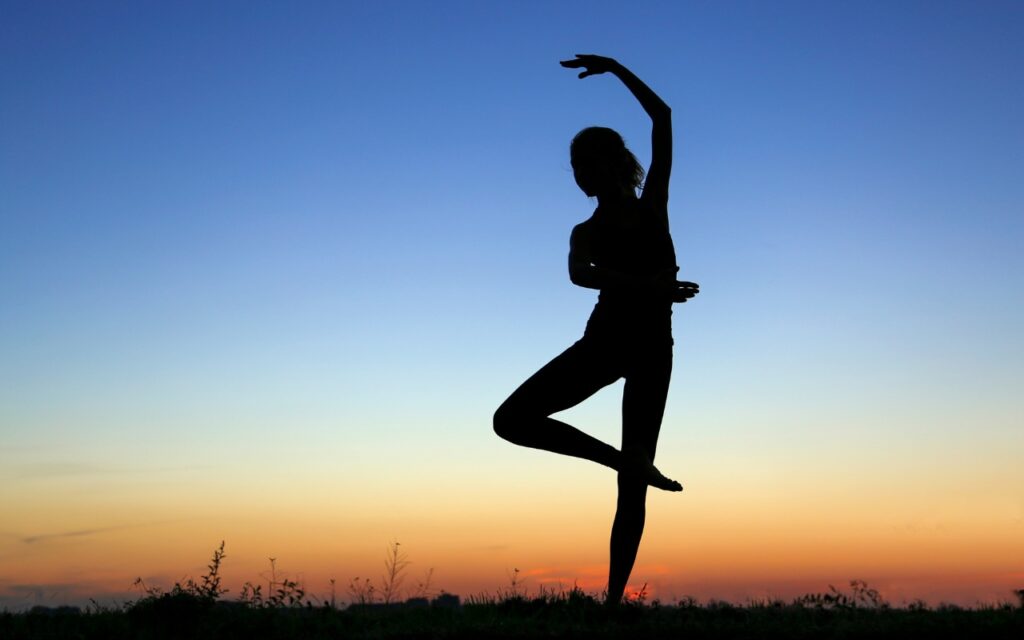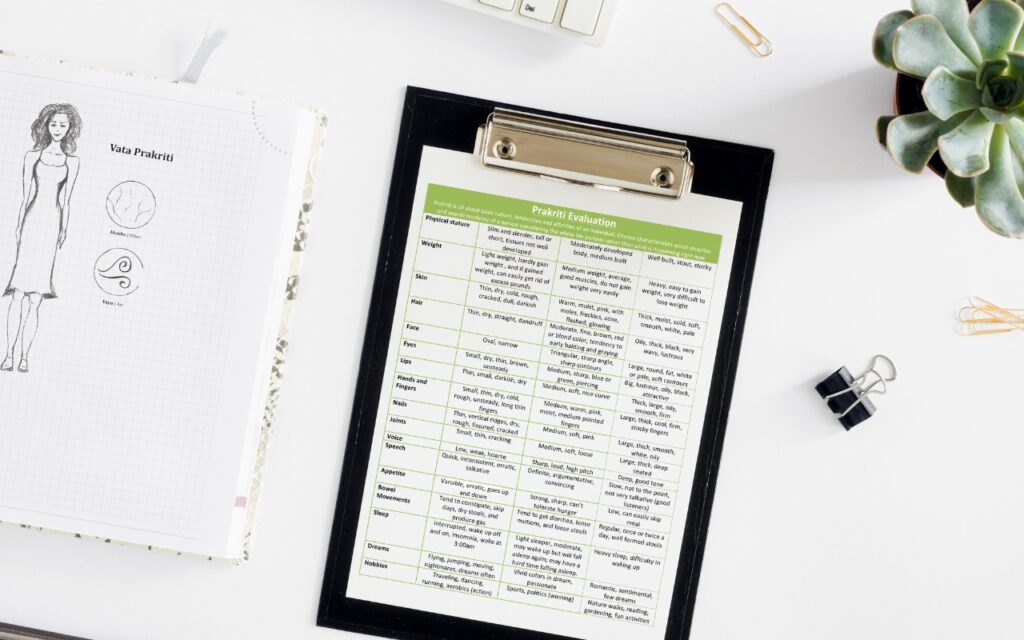Ayurveda is one of the oldest documented medical sciences in the world. This Indian medical science dates back more than 5,000 years and recognizes the interconnectedness of our physical health to emotional, mental, and spiritual state. The primary goal of Ayurvedic medicine is not to relieve symptoms but to establish natural homeostasis for disease prevention. This is achieved through supporting and managing the energetic Doshas of the system. In this article, we’ll explain what these Doshas are and how connecting with them can support your wellbeing.
What are doshas?
The five elements, three Doshas and Prakriti are three closely related concepts, integral to Ayurveda’s holistic approach. Let’s explore them in brief to properly establish the Doshas. Ether, air, fire, water, and earth – these are the five key elements considered as building blocks of the universe. Everything including the living and nonliving things in the universe are made of these foundational elements. The human body is no exception. Interestingly, elements can manifest both as matter and energy. Each creation differs from one another due to varying proportions of these five elements.
What are the qualities of the five elements?
Ether is the most subtle element associated with the quality of space
Air is associated with the quality of movement
Fire is associated with the quality of heat and transformation
Water is associated with the quality of cohesion
Earth is associated with the quality of structure
The Vedic Rishis interpreted the bodily mechanisms on the analogy of the external world. They concluded that the elements also exist in the universe in the form of three energies called Doshas. Often referred to as the Tridoshas: Vata, Pitta, and Kapha are the three Doshas. In Sanskrit “tri” means ”three” and ”Doshas” means “that which can go out of balance.” Each Dosha is a combination of elements, and this creates a dynamic energy that can fluctuate.
Vata is a combination of air and ether elements.
Pitta is a combination of fire and water elements.
Kapha is a combination of earth and water elements.
One of the central concepts in Ayurveda is that the Doshas govern all aspects of physical and mental health. Vata controls movement, Pitta regulates metabolism, and Kapha maintains structure. This maintains homeostasis in the human body. While the Doshas can go out of balance as their names imply, they are all integral to life. Their balanced combination makes life possible, and constitutes health.
The correlation of Ayurvedic Doshas and Prakriti
Ayurveda recognizes that we are all unique individuals. Our inherent physical, mental, and emotional constitution, or Prakriti, occurs due to a specific combination of Doshas at the time of conception. This foundational blueprint remains unchanged throughout our lifetime. Each individual is composed of a unique balance of elements, with some elements in higher quantities than others. This results in the proportions of the Doshas in each individual varies. Most people are dominant in one or two Doshas. By knowing our mind-body constitution, we can make dietary and lifestyle decisions that complement our true selves and promote health.
What are the three Dosha types?

Vata Dosha
Vata is the vital energy that governs all movement in the body. It is composed of the air and ether elements. The air element is associated with movement. The ether element is associated with expansion. When these two elements combine, energy is created that is constantly moving and changing. Vata exists in nature in the form of wind, air, and dust. It is also found in the movements of animals such as birds and squirrels. Vata is predominant in the early morning and late afternoon, in the fall and early winter, and during the later years of life.
Qualities of Vata and manifestations in the mind-body
Dry: Helps reduce dampness, congestion, fluid stagnation, and water retention.
Light: Reduces toxic buildup (Ama), prevents excess weight gain, and makes the body feel lighter and more energetic.
Cold: Removes heat buildup, reduces burning sensation and excess acidity
Subtle: Transports nutrients to the body’s microscopic channels (Srotas)
Rough: Eliminates stickiness, congestion and reduces toxin build-up
Mobile: Transmits energy, nerve impulses; responsible for all kinds of movement in the body.
Functions of Vata in the mind-body system
Vata is responsible for all the voluntary and involuntary movements and functions of the body and mind. It controls blood circulation, breathing, nerve impulse conduction, coordination of sense organs, pumping of the heart, thought processing, and all motor and sensory actions. Opening of the cell walls, transportation of digestive enzymes, and absorption of nutrients are controlled by Vata. It also governs the process of elimination of waste, promotes a healthy balance of thoughts and emotions, and influences the other two Doshas, Pitta and Kapha. Vata Dosha also plays a key role in menstruation, ejaculation, development and delivery of the fetus.
Vata type characteristics
- A lean physique with bony prominent joints
- Tendency to be on the lighter side of the scale
- Skin tends to be dry and rough
- Often cold hands and feet
- Erratic appetite and digestion
- Sensitive to wind
- Displays remarkable mental agility
- Very creative
- Possess very active minds
- Always brimming with innovative ideas
- Boundless enthusiasm but gets exhausted very fast
Signs Vata Dosha is out of balance:
- Extreme roughness of skin
- Pain, pinching, shivering, or tremor sensation
- Delirium
- Vertigo
- Horripilation (goose bumps)
- Astringent taste in the mouth
- Sound in ear
- Red or brown coloration of the body
- Digestion issues like bloating, constipation, and gas
- Frequent joint pain with cracking sounds
- Onset of osteoarthritis, brittle bones
- Difficulty falling asleep or insomnia
- May experience increased levels of fear, anxiety, restlessness
- Struggle with decision-making
What are good Ayurvedic practices and treatments for Vata Dosha?
Warmth, grounding, and moisture are key elements in balancing Vata Dosha. Establishing a routine, eating warm, oily, and nourishing foods, and incorporating grounding activities such as yoga and meditation can be beneficial. Ayurvedic treatments such as Abhyanga (massage with warm oil), Shirodhara (pouring warm oil on the forehead), and Sudation therapy are often recommended to calm and balance Vata Dosha. These treatments help to nourish the nervous system and promote relaxation. Creating a calm and peaceful environment, protecting oneself from cold and wind, and getting enough rest are also important.

Pitta Dosha
Pitta is made up of the elements of fire and water. Often described as the energy of transformation, this Ayurvedic Dosha is associated with qualities such as heat, sharpness, and intensity. The fire element is the source of heat and energy associated with transformation. Water is the stabilizing element, and it helps to keep the intensity of heat in check. In nature, Pitta is represented by the sun, fire, and water. The sun is a source of heat and energy, just like Pitta.
Qualities of Pitta and manifestations in the mind-body
Oily: Keeps skin glowing; balances dryness; emulsifies food for proper digestion
Sharp: Breaks down ingested food into small particles for metabolization; develops a sharp memory with critical thinking ability
Hot: Maintains body temperature
Light: Brings clarity in mind; boosts confidence
Acidic: Impart distinct acidic smell to sweat, urine, blood and bile
Spreading: Converts solid food into homogenized liquid, which aids digestion and smooth flow through the body channels
Functions of Pitta in the mind-body system
Pitta Dosha is responsible for controlling all thermogenesis or heat production. This includes food digestion and metabolism, plus the feeling of thirst. Pitta also maintains body temperature, the coloration of the blood and skin, and the formation of various secretions and excretions of the body.
In the mind, Pitta contributes to the analytic mindset, decision-making, courage, and leadership. While Vata’s movement involves speech, the clarity and precision of that speech is Pitta’s influence. Emotionally, Pitta generates high energy, passion, and intelligence. Pitta is also associated with vision, both physical and mental.
Pitta type characteristics
- Medium, athletic build
- Moderate strength
- Good appetite
- Oily skin, prone to acne
- Aversion to heat and tendency towards excess sweating
- Often goal-oriented
- Assertive logical, rational thinkers
Signs Pitta Dosha is out of balance:
- Eruptions on skin
- Pus formation
- Hysterical Fits
- Unconsciousness
- Excess perspiration with bad odor
- Sour, bitter taste in the mouth
- Excess yellowness in stool, urine, skin, eyes
- Anger, irritability, and frustration.
- Inflammation
- Skin rashes
- Acid reflux
- Overheating
- Feelings of jealousy, resentment
What are good Ayurvedic practices and treatments for Pitta Dosha?
Pitta Dosha is associated with heat. It is crucial to avoid excessive physical heat exposure or situations that would trigger anger or frustration. Eating a cooling diet, rich in fruits and vegetables, and avoiding spicy and acidic foods can be beneficial. Regular, low-intensity exercise like walking in nature is also recommended. Yogic treatments such as Sitali Pranayama are often recommended to cool the body, calm the mind, and promote relaxation.

Kapha Dosha
This Kapha Dosha is a combination of earth and water elements. Earth brings into the qualities of structure, stability, and solidity. Water is associated with the qualities of moistness, coolness, and fluidity. Kapha is also found in the earth itself, and the earth element is most closely associated with Kapha. The earth and its mountains are stable, heavy, and solid, just like Kapha.
Qualities of Kapha and manifestations in the mind-body
Moist: Keeps the optimal level of lubrication in the joints, muscles, and connective tissues for smooth functioning; reduces dryness and friction.
Cold: Maintains pH of the body; acting as cooling / insulation buffer against Pitta’s heat, sharpness, and acidity
Heavy: Nourishes the existing tissues to build weight; helps to build new cells; brings groundedness in the body and mind.
Function of Kapha in the mind-body system
Kapha is responsible for the most solid and structured parts of the mind-body system. With its water and earth elements, Kapha maintains the body’s lubrication and moistens joints. It gives strength and stamina to the overall system and helps develop the body’s tissues. On a more subtle level, Kapha generates forgiveness, love, compassion, calmness, happiness, and contentment.
Kapha type characteristics
- Larger body frame
- Slower metabolism
- Oily, thick skin
- High tolerance to cold temperatures
- Stable and strong immune system
- Gentle nature, empathy, and emotional stability
- Patient, grounded
- Natural ability to provide support and care to others.
Signs Kapha Dosha is out of balance:
- Excess mucus/sputum production
- Stagnant digestion
- Excessive formation of stool
- Heaviness of the body
- Anorexia
- Sweet taste in the mouth
- Laziness
- Whitish coloration of the body
- Tendency towards weight gain and difficulty losing weight
- Depression, lethargy, and attachment
What are good Ayurvedic practices and treatments for Kapha?
Because Kapha Dosha is associated with structure and heaviness, it is important to incorporate stimulating and invigorating practices into the daily routine. Regular exercise, including cardio and strength training, is important for Kapha individuals. Kapha individuals should aim for a light and warming diet, with a focus on whole and unprocessed foods. They should also avoid overeating and snacking, as this can lead to stagnant digestion and weight gain. Avoiding dairy and incorporating warming spices such as ginger, black pepper, and cinnamon can also be beneficial for Kapha individuals. Ayurvedic treatments such as Panchakarma (a full body oil massage) and Swedana (herbal steam therapy) are often recommended to balance Kapha Dosha. These treatments kindle metabolism, detox organs, and revitalize the body and mind.

The Ayurvedic Doshas are keys to unlocking customized treatment plans for optimal health and wellness. This timeless healing science continues to resonate with people seeking a holistic approach to complete well-being. By understanding the Doshas and how they manifest in you, as well as the world around you, it’s possible to live in harmony with your true self and nature.
Want to learn more about the Doshas? Explore our beginner programs.





